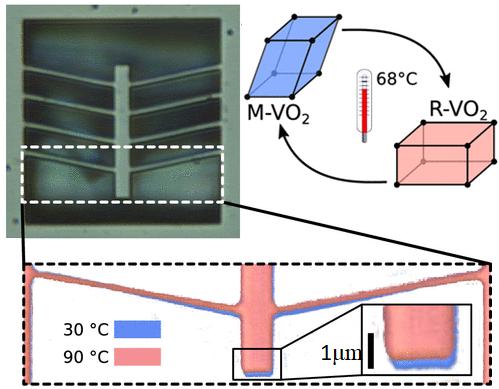A research team including Osaka University reports an ultra-small actuator with the fastest on/off switch and most precise position control in the world

Credit: Osaka University
Osaka, Japan – How do you turn on and off an ultra-small component in advanced technologies? You need an actuator, a device that transmits an input such as electricity into physical motion. However, actuators in small-scale technologies to date have critical limitations. For example, if it’s difficult to integrate the actuator into semiconductor electronics, real-world applications of the technology will be limited. An actuator design that operates quickly, has precise on/off control, and is compatible with modern electronics would be immensely useful.
In a study recently published in Nano Letters, a team including researchers from Osaka University has developed such an actuator. Its sensitivity, fast on/off response, and nanometer-scale precision are unparalleled.
The researchers’ actuator is based on vanadium oxide crystals. Many current technologies use a property of vanadium oxide known as the phase transition to cause out-of-plane bending motions within small-scale devices. For example, such actuators are useful in ultra-small mirrors. Using the phase transition to cause in-plane bending is far more difficult, but would be useful, for example, in ultra-small grippers in medicine.
“At 68°C, vanadium oxide undergoes a sharp monoclinic to rutile phase transition that’s useful in microscale technologies,” explains co-author Teruo Kanki. “We used a chevron-type (sawtooth) device geometry to amplify in-plane bending of the crystal, and open up new applications.”
Using a two-step protocol, the researchers fabricated a fifteen-micrometer-long vanadium oxide crystal attached by a series of ten-micrometer arms to a fixed frame. By means of a phase transition caused by a readily attainable stimulus–a 10°C temperature change–the crystal moves 225 nanometers in-plane. The expansion behavior is highly reproducible, over thousands of cycles and several months.
“We also moved the actuator in-plane in response to a laser beam,” says Nicola Manca and Luca Pelligrino, co-authors. “The on/off response time was a fraction of a millisecond near the phase transition temperature, with little change at other temperatures, which makes our actuators the most advanced in the world.”
Small-scale technologies such as advanced implanted drug delivery devices wouldn’t work without the ability to rapidly turn them on and off. The underlying principle of the researchers’ actuator–a reversible phase transition for on/off, in-plane motion–will dramatically expand the utility of many modern technologies. The researchers expect that the accuracy and speed of their actuator will be especially useful to micro-robotics.
###
The article, “Planar nanoactuators based on VO2 phase transition,” was published in Nano Letters at DOI: https:/
About Osaka University
Osaka University was founded in 1931 as one of the seven imperial universities of Japan and is now one of Japan’s leading comprehensive universities with a broad disciplinary spectrum. This strength is coupled with a singular drive for innovation that extends throughout the scientific process, from fundamental research to the creation of applied technology with positive economic impacts. Its commitment to innovation has been recognized in Japan and around the world, being named Japan’s most innovative university in 2015 (Reuters 2015 Top 100) and one of the most innovative institutions in the world in 2017 (Innovative Universities and the Nature Index Innovation 2017). Now, Osaka University is leveraging its role as a Designated National University Corporation selected by the Ministry of Education, Culture, Sports, Science and Technology to contribute to innovation for human welfare, sustainable development of society, and social transformation.
Website: https:/
Media Contact
Saori Obayashi
[email protected]
Original Source
https:/
Related Journal Article
http://dx.




